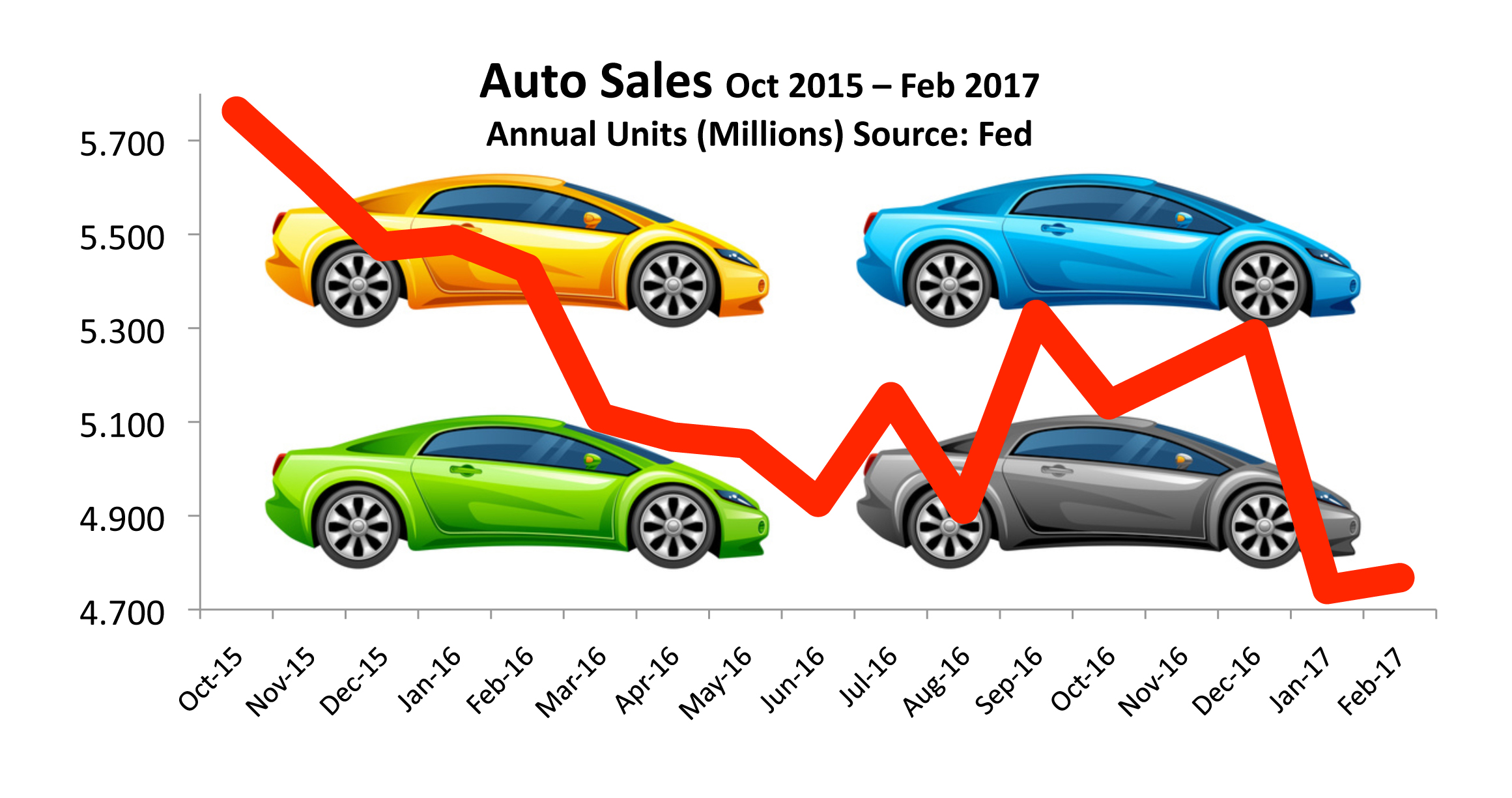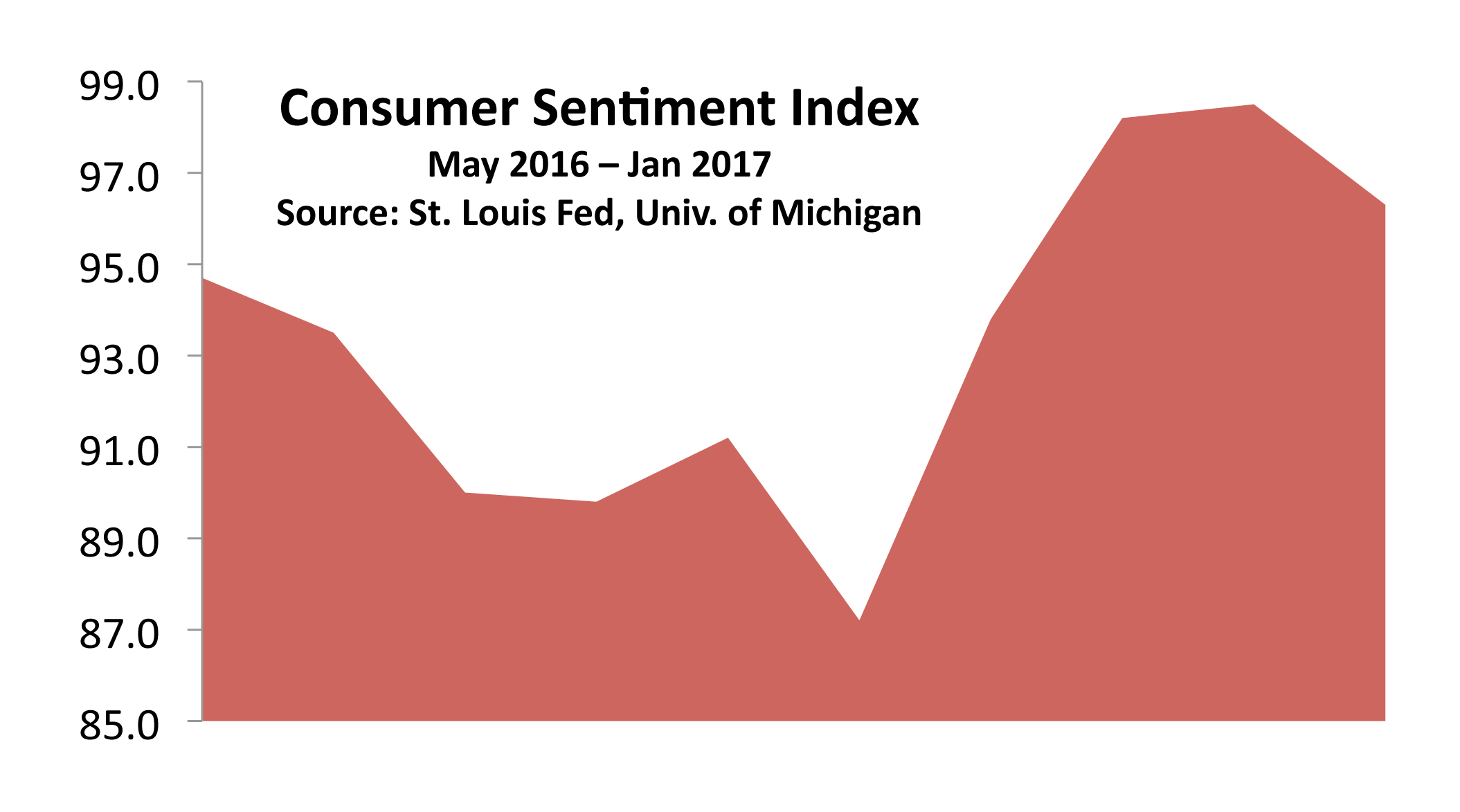Stock Indices:
| Dow Jones | 45,544 |
| S&P 500 | 6,460 |
| Nasdaq | 21,455 |
Bond Sector Yields:
| 2 Yr Treasury | 3.59% |
| 10 Yr Treasury | 4.23% |
| 10 Yr Municipal | 3.20% |
| High Yield | 6.44% |
YTD Market Returns:
| Dow Jones | 7.05% |
| S&P 500 | 9.84% |
| Nasdaq | 11.11% |
| MSCI-EAFE | 20.36% |
| MSCI-Europe | 22.28% |
| MSCI-Pacific | 16.87% |
| MSCI-Emg Mkt | 17.01% |
| US Agg Bond | 4.98% |
| US Corp Bond | 5.30% |
| US Gov’t Bond | 4.81% |
Commodity Prices:
| Gold | 3,516 |
| Silver | 40.76 |
| Oil (WTI) | 64.03 |
Currencies:
| Dollar / Euro | 1.16 |
| Dollar / Pound | 1.35 |
| Yen / Dollar | 147.05 |
| Canadian /Dollar | 0.72 |
Macro Overview

Domestic equity indices ended positive for the first quarter of 2017. The Dow Jones Industrial Index was up 4.6%, the S&P 500 Index returned 5.5%, and the technology heavy Nasdaq ended the quarter with a 9.8% gain. Many believe that an underlying global recovery may be underway, leading to domestic equity demand here in the U.S.
The Fed hiked short-term rates as expected in March, on track with two additional hikes in 2017 with improving economic data validating the Fed’s continuance of rate increases. The Fed has so far increased rates only three times in the past 16 months, one of its slowest paces ever. Fixed income analysts view the Fed’s decision to set two additional rate hikes in 2017 as a normalization of the interest rate environment, away from further accommodative policy producing low rates.
President Trump’s political capabilities are being tested as he needs to substantiate that he can formalize legislative arrangements rather than business transactions. The inability to initiate a bill to repeal the Affordable Care Act (ACA) created uncertainty as to whether or not future legislative ambitions would prove more challenging. In addition to resuscitating a health care bill, tax reform is expected to be President Trump’s next objective, which many expect easier to tackle since lower taxes are a common theme among the divided Republican party.
Two well respected measures of how consumers feel and how they perceive the economic environment showed dramatic increases in their most recent data: the Consumer Confidence Index, compiled by the Conference Board, and the Consumer Sentiment Index, prepared by the University of Michigan, both elevated to record levels. Since consumer expenditures make up nearly 70% of Gross Domestic Production (GDP), growing confidence among consumers is deemed optimistic by economists.
Leveraged investors turned net bullish on Mexico’s peso for the first time since Donald Trump all but locked up his bid to become the Republican party’s nominee in May, according to the latest data from the U.S. Commodity Futures Trading Commission. It’s a turnaround from when bearish positions reached a record in October amid speculation Trump’s pledges to support U.S. manufacturing would be a disaster for Mexico’s export-dependent economy. Mexican Peso closed the quarter at 18.74 per USD. (Sources: Federal Reserve, Dept. of Commerce, Dow Jones, S&P and Bloomberg).

 The first quarter saw all of the major equity indices end positive, with the Dow Jones Industrial Index ending up 4.6%, the S&P 500 Index returned 5.5%, and the Nasdaq ended the quarter with a 9.8% gain. The S&P 500 index peaked on March 1st, ending lower at quarter end yet still up for the quarter as its sixth straight positive quarter.
The first quarter saw all of the major equity indices end positive, with the Dow Jones Industrial Index ending up 4.6%, the S&P 500 Index returned 5.5%, and the Nasdaq ended the quarter with a 9.8% gain. The S&P 500 index peaked on March 1st, ending lower at quarter end yet still up for the quarter as its sixth straight positive quarter.
 Low interest rates and aggressive leasing programs have made some fairly expensive cars affordable. Rather than struggling to get approved for a new home loan or refinance, Americans have instead financed cars, where getting a loan approval has been easier. The abundance of attractive loans has helped elevate auto sales throughout the country over the past few years. Recent auto sales have been slowing across the country as dealer incentives have become less effective.
Low interest rates and aggressive leasing programs have made some fairly expensive cars affordable. Rather than struggling to get approved for a new home loan or refinance, Americans have instead financed cars, where getting a loan approval has been easier. The abundance of attractive loans has helped elevate auto sales throughout the country over the past few years. Recent auto sales have been slowing across the country as dealer incentives have become less effective.
 A primary determinant for the Fed’s decision to raise rates is inflation. As part of its monetary policy objectives, the Fed had set a 2% target for consumer inflation as a trigger for sustained rate increases.
A primary determinant for the Fed’s decision to raise rates is inflation. As part of its monetary policy objectives, the Fed had set a 2% target for consumer inflation as a trigger for sustained rate increases.
 The world’s best currency rally this year is finding fresh support from hedge funds. Investors have made the peso the world’s best performer this year, sending it up 11 percent against the dollar, after it plunged to record lows in the aftermath of Trump’s victory. The rally was driven by the idea that the selloff had been too sharp given the lack of clarity about Trump’s exact trade policies as well as friendly comments from U.S. officials. For many analysts The Trump agenda is no longer as frightening as it once was. But there are signs the run might falter as
The world’s best currency rally this year is finding fresh support from hedge funds. Investors have made the peso the world’s best performer this year, sending it up 11 percent against the dollar, after it plunged to record lows in the aftermath of Trump’s victory. The rally was driven by the idea that the selloff had been too sharp given the lack of clarity about Trump’s exact trade policies as well as friendly comments from U.S. officials. For many analysts The Trump agenda is no longer as frightening as it once was. But there are signs the run might falter as  short positions approach zero. Since 2014, whenever bearish bets reached that level, there was a major reversal with a significant rebuild of peso shorts. Another sign that the peso’s time in the sun may be nearing its end? Seasonality. The first quarter has tended to coincide with an advance in the currency, which generally experiences weakness through the rest of the year. (Source: Bloomberg)
short positions approach zero. Since 2014, whenever bearish bets reached that level, there was a major reversal with a significant rebuild of peso shorts. Another sign that the peso’s time in the sun may be nearing its end? Seasonality. The first quarter has tended to coincide with an advance in the currency, which generally experiences weakness through the rest of the year. (Source: Bloomberg)